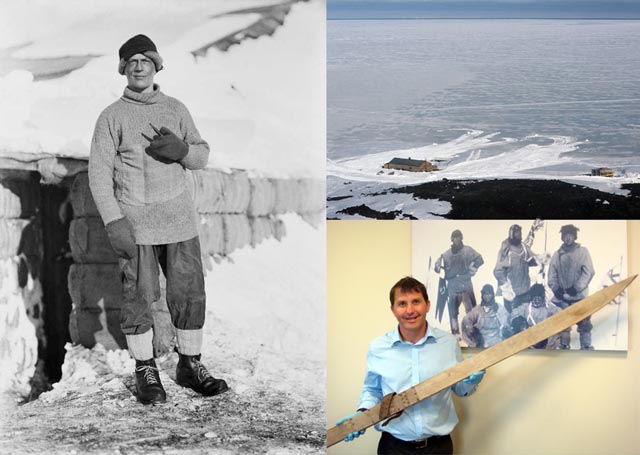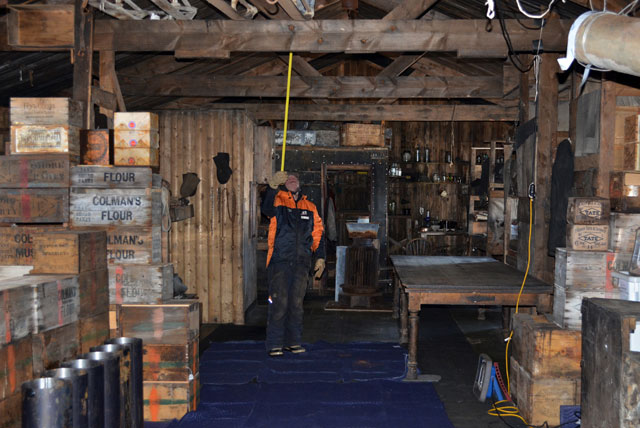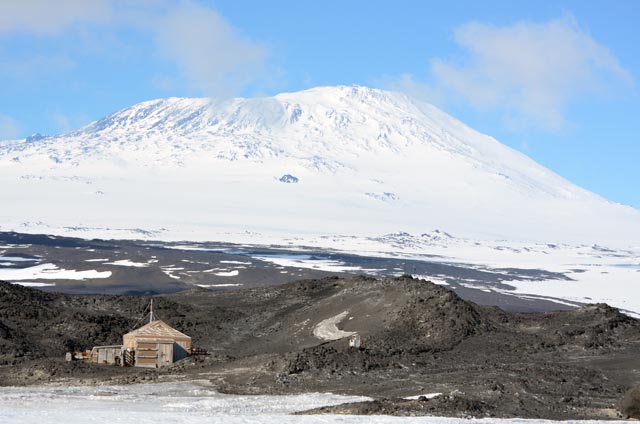|
Rightful placeSki artifacts, Shackleton whisky return to Antarctic expedition basesPosted February 15, 2013
Exactly a century after the end of the Terra Nova Expedition A set of wooden skis belonging to Edward Atkinson has been donated to New Zealand’s Antarctic Heritage Trust The 1910-12 Terra Nova Expedition, officially called the British Antarctic Expedition, was the second of Scott’s journeys to the Antarctic. It ended with his death and those of four companions who accompanied him on a quest to be the first to reach the geographic South Pole. Norwegian Roald Amundsen beat them to the prize by about six weeks. The Britons perished on the return journey, just 11 miles from a supply depot on the Ross Ice Shelf Atkinson was a Royal Navy surgeon who served as physician on the expedition, named after the team’s ship, Terra Nova. He was in command of the base at Cape Evans during much of 1912. He led the party that found the tent containing the bodies of Scott, Lt. Henry Robertson (Birdie) Bowers and fellow physician Edward Wilson. It was also Atkinson, with Terra Nova commander Harry Pennell, who rowed into the New Zealand port of Oamaru on Feb. 10, 1913, to relay the news about the death of Scott and his party to the rest of the world. Two days later, the Terra Nova sailed into Lyttelton harbor with its flag at half-mast. The wooden skis, etched with Atkinson’s initials (ELA), were retrieved from a pile of abandoned equipment at Scott’s Cape Evans hut in 1948 by U.S. Navy helicopter pilot Lloyd Tracy, who had served aboard the USS Edisto. The ship was part of Operation Windmill, the U.S. Navy’s second post-World War II expedition to the Antarctic. Tracy’s son, Dick Tracy, donated the skis to the Antarctic Heritage Trust, which is based in Christchurch, the South Island’s largest city and a major gateway to the Antarctic for more than a century. “It is with great joy that after many years these will be returned to Cape Evans from where dad recovered them,” Dick Tracy said in a press release from the Antarctic Heritage Trust. “The provenance of the skis is beyond doubt,” confirmed Nigel Watson, executive director of the Antarctic Heritage Trust. “These are a most poignant link to Capt. Scott’s last expedition. “It seems like fate that these have been returned to Christchurch exactly 100 years to the day after Atkinson himself returned here from the Antarctic with details of the loss of the polar party,” he added. Dick Tracy said later in an e-mail that like his father, he was a collector of “stuff” and it had come time to clean out the house. “I have begun looking to get rid of most of the things I have collected over the years but the skis I felt were special,” he wrote. “I didn't feel it was right for me to keep them myself.” Dick Tracy started an online search through e-mail to find the best home for the skis. “When Nigel called from the AHT, I knew that the right person had found me,” he said. “I am very relieved that I am no longer responsible for safety of the skis. I would have felt bad if something had happened to them.” The 2012-13 summer season in Antarctica is beginning to wind down, with the last flight from Ross Island tentatively scheduled for March 5. Paula Granger, communications and events manager for the Antarctic Heritage Trust, said the skis will most likely be returned to Cape Evans next austral summer. “The skis have just arrived, and they will need to be condition assessed by a conservator and may require conservation treatment before being returned,” she said. “The team will also look at photographic evidence to try and ascertain the most appropriate place to locate the skis.” Atkinson’s pair of skis isn’t the only historic artifact to find its way back to the Antarctic this year. New Zealand Prime Minister John Key, during a visit to his country’s research station Scott Base One crate had been flown to the Canterbury Museum “The whisky provided a unique opportunity to apply modern sensory and chemical analytical methods to establish the flavour and composition of a product manufactured more than one hundred years ago,” according to the Antarctic Heritage Trust. The whisky traveled back to Antarctica on Jan. 17. The handover took place in the Antarctic Heritage Trust’s conservation lab at Scott Base, where the Trust’s conservation team works over the winter to restore artifacts from the Scott and Shackleton expedition bases. All three whisky crates will be returned to Cape Royds after conservation work has been completed. |



For USAP Participants |
For The Public |
For Researchers and EducatorsContact UsU.S. National Science FoundationOffice of Polar Programs Geosciences Directorate 2415 Eisenhower Avenue, Suite W7100 Alexandria, VA 22314 Sign up for the NSF Office of Polar Programs newsletter and events. Feedback Form |





